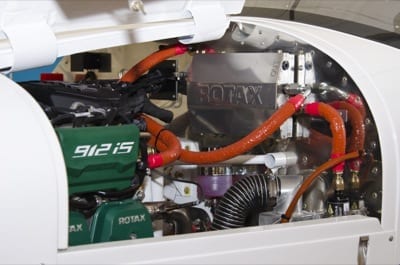In a product launch somewhat comparable to an Apple product event, BRP Rotax recently drew a large group of attendees to its facility in Gunskirchen, Austria, to launch its new 912 iS engine. In the tech world, “i” means Internet. In the light aviation world, or more specifically BRP Rotax’s world, “i” now means injected.
“Pilots will appreciate the easier pre-flight check and starting procedures offering them an enhanced flight experience,” stated Rotax/BRP officials. They add that this removes “the need for servicing and synchronizing the carburetors every 200 hours.” Fuel injection also “eliminates” carburetor icing. Users of the engine will appreciate these improvements.
 Fuel injection is controlled by an Electronic Control Unit (ECU) similar to automotive applications. A mechanic can connect to the ECU with a laptop for easier maintenance. Rotax engineers employ the ECU to time and configure each fuel input. All cylinders also use two fuel injectors per cylinder for redundancy much like dual spark plugs on carbureted aircraft engines.
Fuel injection is controlled by an Electronic Control Unit (ECU) similar to automotive applications. A mechanic can connect to the ECU with a laptop for easier maintenance. Rotax engineers employ the ECU to time and configure each fuel input. All cylinders also use two fuel injectors per cylinder for redundancy much like dual spark plugs on carbureted aircraft engines.
A look at the engine parts on the new special 912 iS website shows Rotax is thinking green. The Austrian producer is positioning the 912 iS to be an environmentally-friendly engine thanks to improved fuel economy and with lower emissions as major elements of the design.
More 912 iS engine facts: It maintains the same output (100 horsepower) as do current carbureted versions of the 912. However, they scrapped the Bing carburetors that demanded periodic adjustment. The company claims up to 30% lower fuel consumption than competing aircraft engines providing the same power.
Physically, the 912 iS remain essentially the same size as earlier 912 engines. However, the weight increased about 13 pounds, totaling about 140 pounds installed weight before fluids. The engine has an external alternator to power both the ECU and aircraft systems.
BRP reported that the engine can be ordered in two versions: non-certified or for certified aircraft. The 912 iS features the same 2,000-hour time between overhauls (TBO) as the present 912 engines. For those concerned, the 912 iS can use premium autogas up to E10.
Jan Fridrich, who attended the Rotax launch event, reported the following airplanes were shown with the new installation: Flight Design CTLSi; Evektor Harmony; Skyleader 600; WT 9 Dynamic; TL Sting S4; TL Sirius 3000; FK-14 Le Mans; Tecnam P2008 LSA; Breezer B600; Pipistrel Virus SW iS; and two autogyros: Auto Gyro cavalon and Arrow copter AC 10.
For more on Sport Pilot and LSAs: ByDanJohnson.com
People who read this article also read articles on airparks, airshow, airshows, avgas, aviation fuel, aviation news, aircraft owner, avionics, buy a plane, FAA, fly-in, flying, general aviation, learn to fly, pilots, Light-Sport Aircraft, LSA, and Sport Pilot.

Which places the aircraft industry only a few decades behind the automotive industry. At least it’s beginning to leave the stick-in-the-mud attitude behind  it.